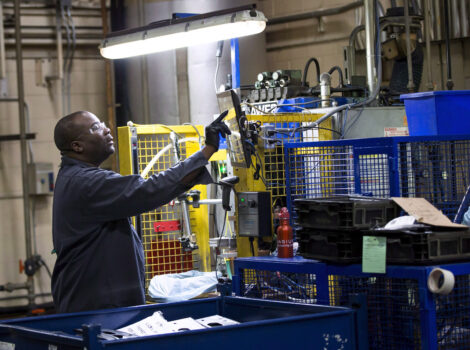Manufacturings Opportunity to Shine at Home
COVID-19 pandemic could revitalize manufacturing in Canada by reducing supply chain risks and relian..
COVID-19 pandemic could revitalize manufacturing in Canada by reducing supply chain risks and reliance on China
News Analysis
If theres one lesson that has emerged from the COVID-19 pandemic, its that Canada needs to ensure it can manufacture essential medical equipment. The outbreak is the latest turning point in a bigger picture for manufacturers to reduce risk in their supply chains and, notably, lower their dependence on China.
Politicians, including Ontario premier Doug Ford and U.S. President Donald Trump, have been pounding the table on bringing manufacturing back home and minimizing reliance on far-away regions.
Rob Wildeboer, executive chairman of auto parts manufacturer Martinrea International, told The Epoch Times that hes optimistic for manufacturings future in Canada, that it will be better perceived. The sector could well be deemed more critical to the security of Canadas economy and its people.
“The question for a lot of people is going to be: Do I have to buy from China and can I make that here? Am I willing to pay the higher prices?” said Wildeboer. “The public gets it.”
The need to lower the chance of disruptions to supply chains and find alternatives didnt start overnight. It began to build after Canada saw its manufacturing getting hollowed out as companies outsourced production to China and its cheap labour after that country was accepted into the World Trade Organization (WTO) two decades ago.
“There were certain expectations on how the Chinese would be part of the WTO, the benefit from trade and so forth,” Wildeboer said. “And at the end of the day, thats not the world that were seeing today.”
“The reality is we put a lot of our supply chains at risk, our manufacturing at risk. It has to be an even game or its not sustainable over the long term,” Wildeboer said.
Martinrea, which employs about 17,000 people in Canada, the United States, and eight other countries including China, has relatively low exposure to China, where its production serves the Chinese market almost exclusively.
Western economies have long thought the Chinese regime would act in a more democratic manner, respecting international norms. But it didnt. As a result, the Trump administration initiated a trade war to take China to task for untoward acts including intellectual property theft and forced transfers of technology in joint ventures.
The China Risk
“Theyre not the most reliable partner [China] especially in times of crises … so companies are trying to mitigate that risk,” Dennis Darby, president and CEO of Canadian Manufacturers & Exporters (CME), told The Epoch Times. He also said China as we know it is not entirely a market economy—its not open and not transparent.
In addition, during the CCP (Chinese Communist Party) virus, commonly known as the novel coronavirus, pandemic, the Chinese regime is being accused of mismanaging the spread, falsifying the number of cases and deaths, and even hoarding medical supplies as a bargaining chip.
As China developed rapidly and became Canadas second-largest trading partner by 2015, after the United States, manufacturing costs there rose and other countries—like Vietnam and Bangladesh—became more attractive, Andrew Sharpe, economist and executive director of the Centre for the Study of Living Standards (CSLS), told The Epoch Times.
But Canadas corporate sector is not like that of the United States, which has many large multinationals across diverse industries.
“Canada is not as integrated as other countries in terms of supply chains,” Sharpe said, which indicates that globalization of supply chains is a more acute problem for other nations. “The European countries are far more integrated.”
Bringing It Back Home
Globalization has been a mixed bag. Cheap labour in China and other parts of Asia has led to North American companies becoming more profitable, but it has gutted Canadian and American manufacturing. It has also made manufacturers more vulnerable to events in places halfway around the world.
A 2017 CSLS study showed that in Canada, employment in the manufacturing sector grew at 2.7 percent a year from 1992 to 2000. But it fell by 1.9 percent annually from 2000 to 2008—a time of rapid growth of Chinese imports penetrating Canadian manufacturing—and fell by 1.7 percent annually from 2008 to 2015. Over that entire 1992–2015 period, total Canadian employment went up 1.5 percent per year, which illustrates the downfall of employment in manufacturing starting in 2000.
Sharpe says the shock of Chinese imports on Canadian manufacturing plateaued around 2014 to 2015, but Canada is also importing from other lower-cost Asian countries.
Manufacturing in Canada, which employs 1.7 million in full-time well-paying jobs, has declined as a share of the economy, to just under 11 percent last year.

“We need to have a level of supply security in Canada … for these types of pandemics when they occur,” said John Stanfield, president and CEO of Nova Scotia-based garment manufacturer Stanfields, in an interview with BNN Bloomberg. Its “a call to governments and the private sector especially manufacturing that has been largely decimated over the years in Canada,” he said.
Stanfields is making medical gowns for front-line workRead More – Source

